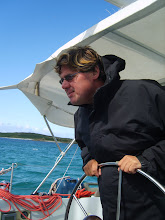Weather windows are a difficult subject among sailors. Do you need an entire period of safe sailing or are forecasts worthless after five days?

I've always tried to hang on to forecasts as long as possible. Even when the actual conditions weren't the way the forecast predicted, I've always used them to understand what was going on. It helps to study weather fenomena extensively, of course. I've been watching weather develop for ten years now, and I've got a decent idea where it's all coming from and what the effects are.
But the most difficult part of understanding weather is trying to get a grip on the medium term forecast three to five days on, and devising strategies to handle what it throws at you in the middle of the ocean.
Being without detailed forecasts for ten days in the middle of the Atlantic did my interpreting skills a lot of good. With just a general synopsis, limited to the hazards to shipping from Bermuda Navtex, I drew my own little maps and tried to devise what the wind would do next. The best I got from that were short term forecasts, and they couldn't account for everything we got in those days.
I realized the relativity of long term forecasts even better than I already had in the past. They depend heavily on up-to-date information, something we couldn't get without satellite phone. But at least it didn't get us into trouble, like when we evaded the Easterly gale with a three days out of date forecast.
So we come back to the weather window. Is it good up to three days into the future, or is only the next day forecast dependable? It of course depends on the area you are in. In the Western Europe waters, the weather is highly unpredictable. Today we're getting a forecast for a gale passing tomorrow, and its position has shifted by a couple hundred Miles in the past few days. When we leave tomorrow night, we'll get a second, smaller depression to provide us with good winds for the first three days. Or so the forecast says. But it could be more, less, or from a slightly different direction.
So does this help us make a good decision on when to leave - and where to?
Well it helps, but if it will turn out to be adequate for a good crossing, is something that remains to be seen. With good continuing weather updates, we will hopefully escape the worst and get the best wind for a fast crossing. But that gale that's still lurking on the East coast of the U.S., might get us in the end, just before we reach the Isles of Scilly. Because that is ten days on, and no forecast can predict the weather in a certain location that far into the future.
So for that gale we might come to depend on our fallback position, which is a very sturdy boat and a hardened crew.

